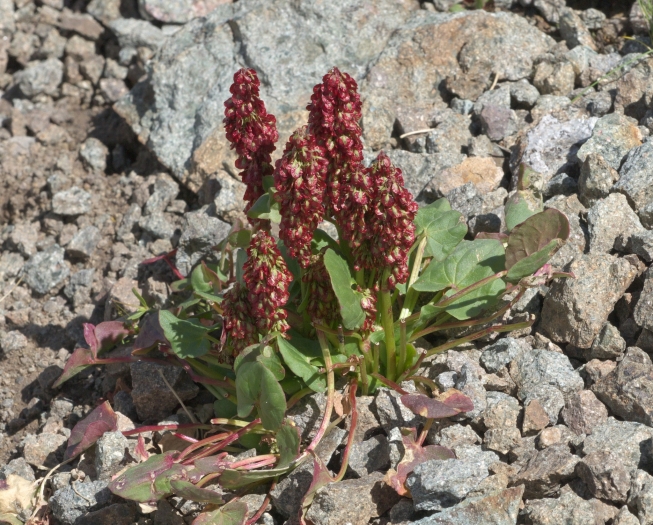Mountain Sorrel
(Oxyria digyna)
Mountain Sorrel (Oxyria digyna)
/
/

Robert Webster
CC BY-SA 4.0
Image By:
Robert Webster
Recorded By:
Copyright:
CC BY-SA 4.0
Copyright Notice:
Photo by: Robert Webster | License Type: CC BY-SA 4.0 | License URL: http://creativecommons.org/licenses/by-sa/4.0/ | Rights Holder: Robert Webster | Publisher: iNaturalist | Date Created: 2011-08-23T17:45:10-07:00 |























Estimated Native Range
Summary
Oxyria digyna, commonly known as Mountain Sorrel, is a perennial herb that is adapted to the harsh conditions of Arctic regions and high mountains across the Northern Hemisphere, including the Rocky Mountains, the Alps, and the Himalayas. It typically grows 4-12 inches tall and forms dense tufts. The leaves are kidney-shaped with a waxy coating, and the stems are reddish. During the flowering season, which occurs in the short summer months, Mountain Sorrel produces small, inconspicuous green flowers that mature into reddish clusters. The fruit is a distinctive red-winged nut that is dispersed by wind.
Mountain Sorrel is valued for its hardiness and ability to survive in extreme environments, making it a fascinating plant for rock gardens and alpine collections. It is also historically significant as a source of vitamin C; indigenous peoples have used it to prevent scurvy. In cultivation, it requires well-drained, rocky or sandy soil and full sun to part shade. It is generally low-maintenance but needs consistent moisture to mimic its natural snow-bed habitat. While not commonly used for culinary purposes, its leaves can add a tart flavor to salads. Gardeners should be aware that in optimal conditions, it can spread readily, but it is not typically aggressive.CC BY-SA 4.0
Mountain Sorrel is valued for its hardiness and ability to survive in extreme environments, making it a fascinating plant for rock gardens and alpine collections. It is also historically significant as a source of vitamin C; indigenous peoples have used it to prevent scurvy. In cultivation, it requires well-drained, rocky or sandy soil and full sun to part shade. It is generally low-maintenance but needs consistent moisture to mimic its natural snow-bed habitat. While not commonly used for culinary purposes, its leaves can add a tart flavor to salads. Gardeners should be aware that in optimal conditions, it can spread readily, but it is not typically aggressive.CC BY-SA 4.0
Plant Description
- Plant Type: Herb
- Height: 0.5-1.5 feet
- Width: 0.5-1.5 feet
- Growth Rate: Moderate
- Flower Color: Brown, Green, Red
- Flowering Season: Summer, Fall
- Leaf Retention: Deciduous
Growth Requirements
- Sun: Full Sun, Part Shade
- Water: Medium
- Drainage: Fast, Medium
Common Uses
Edible*Disclaimer: Easyscape's listed plant edibility is for informational use. Always verify the safety and proper identification of any plant before consumption., Low Maintenance, Rock Garden
Natural Habitat
Native to Arctic regions and high mountains across the Northern Hemisphere, including the Rocky Mountains, the Alps, and the Himalayas
Other Names
Common Names: Alpine Sorrel, Wood Sorrel, Fjellsyre, Mountain Sorrel
Scientific Names: , Oxyria digyna, Acetosa digyna, Donia digyna, Donia sapida, Lapathum digynum, Oxyria acida, Oxyria acida, Oxyria acida, Oxyria digyna f. elatior
GBIF Accepted Name: